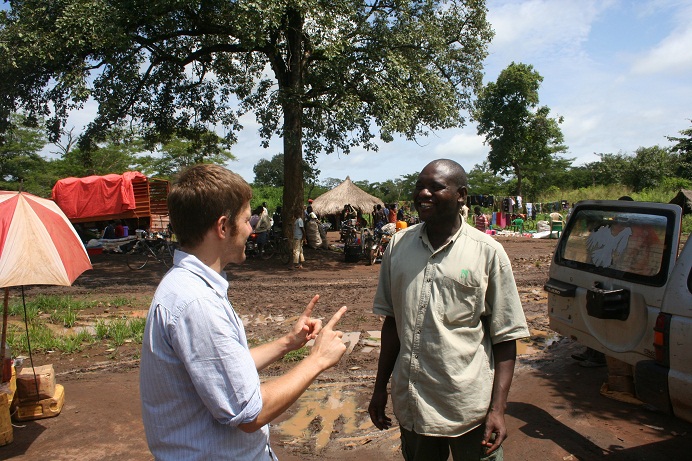Paul Ronan of Resolve (our policy and advocacy partners) is blogging from the region currently affected by LRA activity. He was halfway through a five-week research trip when Kony 2012 launched.
Reposted from The Resolve Blog:
Yesterday I visited the geographic heart of LRA violence in central Africa, a small town called Ezo where the borders of South Sudan, Central African Republic, and Congo all converge. Every weekend, people from all three countries gather at a border market there to trade goods, catch up with distant family and friends, and exchange information on LRA activity.
My visit there was immensely encouraging, as local leaders told me how the LRA has not attacked the area in over six months, allowing thousands of people displaced by the LRA to return to their farms. This was a far cry from my first visit here in 2010, where people were still traumatized by a recent attack in which LRA forces occupied the center of town for an entire night, knocking down doors, looting goods, and abducting women gathered to sing and worship in the local church.
But below the surface, people in Ezo are still frightened. They know LRA attacks are extremely unpredictable, and the recent resurgence of LRA raids just across the border in Congo has heightened fear that their communities will be targeted next. One farmer’s comment summed up what I heard time and time again when I asked people when they will feel truly safe: “We will know we are free when Kony is captured.” A simplistic answer perhaps, but it speaks to a broader truth that cannot be ignored: As long as Kony and the LRA are allowed to run free, hundreds of thousands of people in the region will go to sleep each night afraid for their future.
Amazingly, several community leaders in Ezo had heard of the Kony 2012 campaign. All were overwhelmingly happy to know there was renewed attention on the need to stop Kony and senior LRA commanders from committing attacks. (I’d urge any critic of the Kony 2012 campaign who dares say the LRA is no longer a threat to spend a few nights in rural Ezo). One religious leader who had seen the video even said it would encourage ideas on how local leaders could advocate with government officials to get them to do more to address the conflict.
Much has been written in recent weeks about the reactions to the campaign by people in Uganda, which is immensely important given the history of the conflict and the fragility of current transitional justice processes there. But it’s equally important that commenters get the opinion of the people who are living – right now – under the shadow of LRA violence. And so far, their voices have been largely absent from the conversation (though not from the broader debate about how to stop the LRA).
Of course, even the farmers who told me that they need proof of Kony’s demise to feel safe know that merely arresting one man is not the silver bullet for their problems. Families in Ezo will struggle for years to rejuvenate abandoned farms, assist people traumatized by LRA violence, and heal community bonds ripped apart by war and displacement. They will do so mostly with their own sweat, patience, prayer, and tears. We, as the international community, can only hope to play a supporting role to their efforts.
But even as we reaffirm that our role is in the supporting case, we won’t shy away from our belief that stopping Kony is a necessary step towards lasting peace, and that the US is uniquely positioned to help accomplish this as part of the President’s comprehensive strategy to protect and assist LRA-affected communities. And make no mistake – this is a belief informed by hundreds of conversations we’ve had over the past three years with people currently under threat of LRA violence. These conversations have inspired, haunted, and driven us, and will continue to do so until Joseph Kony and the LRA no longer threaten the lives of innocent civilians.
–Paul
(photo credit: Resolve)

Think people should hear about this?